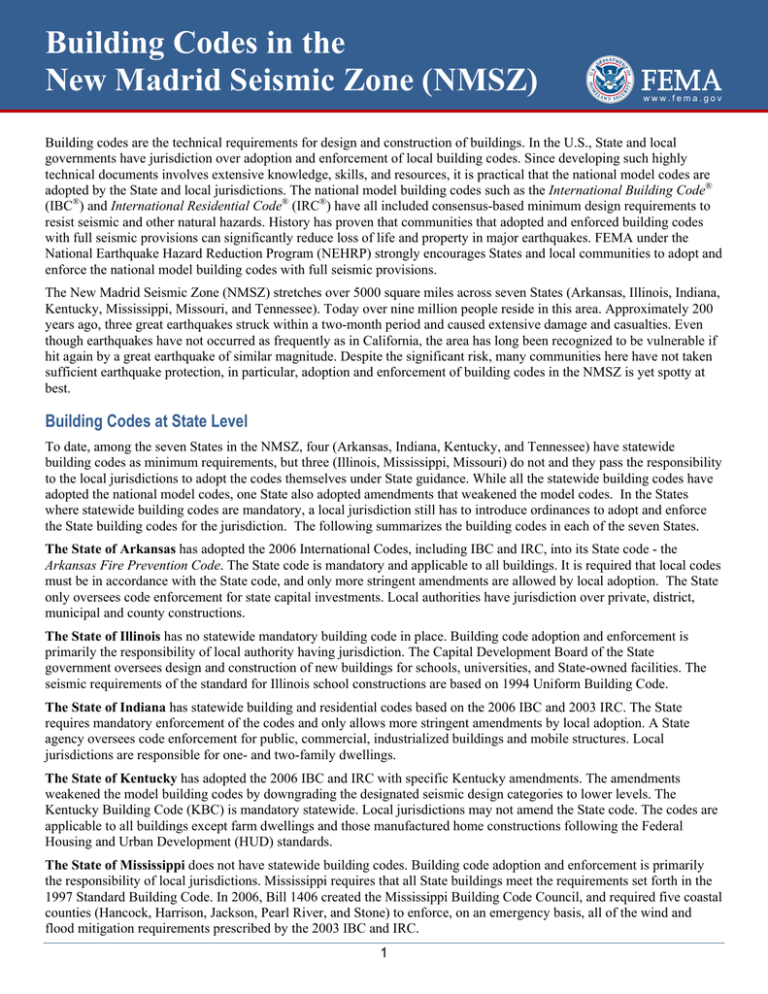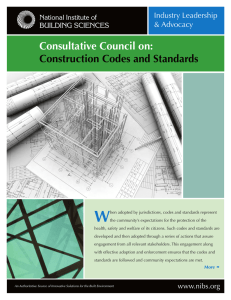Building Codes in the New Madrid Seismic Zone (NMSZ)
advertisement

Building Codes in the New Madrid Seismic Zone (NMSZ) www.fema.gov Building codes are the technical requirements for design and construction of buildings. In the U.S., State and local governments have jurisdiction over adoption and enforcement of local building codes. Since developing such highly technical documents involves extensive knowledge, skills, and resources, it is practical that the national model codes are adopted by the State and local jurisdictions. The national model building codes such as the International Building Code® (IBC®) and International Residential Code® (IRC®) have all included consensus-based minimum design requirements to resist seismic and other natural hazards. History has proven that communities that adopted and enforced building codes with full seismic provisions can significantly reduce loss of life and property in major earthquakes. FEMA under the National Earthquake Hazard Reduction Program (NEHRP) strongly encourages States and local communities to adopt and enforce the national model building codes with full seismic provisions. The New Madrid Seismic Zone (NMSZ) stretches over 5000 square miles across seven States (Arkansas, Illinois, Indiana, Kentucky, Mississippi, Missouri, and Tennessee). Today over nine million people reside in this area. Approximately 200 years ago, three great earthquakes struck within a two-month period and caused extensive damage and casualties. Even though earthquakes have not occurred as frequently as in California, the area has long been recognized to be vulnerable if hit again by a great earthquake of similar magnitude. Despite the significant risk, many communities here have not taken sufficient earthquake protection, in particular, adoption and enforcement of building codes in the NMSZ is yet spotty at best. Building Codes at State Level To date, among the seven States in the NMSZ, four (Arkansas, Indiana, Kentucky, and Tennessee) have statewide building codes as minimum requirements, but three (Illinois, Mississippi, Missouri) do not and they pass the responsibility to the local jurisdictions to adopt the codes themselves under State guidance. While all the statewide building codes have adopted the national model codes, one State also adopted amendments that weakened the model codes. In the States where statewide building codes are mandatory, a local jurisdiction still has to introduce ordinances to adopt and enforce the State building codes for the jurisdiction. The following summarizes the building codes in each of the seven States. The State of Arkansas has adopted the 2006 International Codes, including IBC and IRC, into its State code - the Arkansas Fire Prevention Code. The State code is mandatory and applicable to all buildings. It is required that local codes must be in accordance with the State code, and only more stringent amendments are allowed by local adoption. The State only oversees code enforcement for state capital investments. Local authorities have jurisdiction over private, district, municipal and county constructions. The State of Illinois has no statewide mandatory building code in place. Building code adoption and enforcement is primarily the responsibility of local authority having jurisdiction. The Capital Development Board of the State government oversees design and construction of new buildings for schools, universities, and State-owned facilities. The seismic requirements of the standard for Illinois school constructions are based on 1994 Uniform Building Code. The State of Indiana has statewide building and residential codes based on the 2006 IBC and 2003 IRC. The State requires mandatory enforcement of the codes and only allows more stringent amendments by local adoption. A State agency oversees code enforcement for public, commercial, industrialized buildings and mobile structures. Local jurisdictions are responsible for one- and two-family dwellings. The State of Kentucky has adopted the 2006 IBC and IRC with specific Kentucky amendments. The amendments weakened the model building codes by downgrading the designated seismic design categories to lower levels. The Kentucky Building Code (KBC) is mandatory statewide. Local jurisdictions may not amend the State code. The codes are applicable to all buildings except farm dwellings and those manufactured home constructions following the Federal Housing and Urban Development (HUD) standards. The State of Mississippi does not have statewide building codes. Building code adoption and enforcement is primarily the responsibility of local jurisdictions. Mississippi requires that all State buildings meet the requirements set forth in the 1997 Standard Building Code. In 2006, Bill 1406 created the Mississippi Building Code Council, and required five coastal counties (Hancock, Harrison, Jackson, Pearl River, and Stone) to enforce, on an emergency basis, all of the wind and flood mitigation requirements prescribed by the 2003 IBC and IRC. 1 The State of Missouri relies on the local jurisdictions to adopt and enforce their own building codes. The State only demands that projects for State-owned facilities must be designed in accordance with the latest edition of the IBC. The State of Tennessee adopted the 2006 IBC in September 2008 as the statewide building code. The State has recently adopted the 2009 IRC and made it applicable to new residential construction or change of use to residential effective on or after October 1, 2010. Building Codes at Local Level Whether a State mandates a statewide building code or allows its local jurisdictions to adopt building codes by themselves, regulation of building design and construction is primarily conducted through authorities of local jurisdiction. Local jurisdictions include cities, towns, townships, boroughs, villages, counties, and parishes. Due to various challenges at the local level, building code adoption and enforcement by the local jurisdictions can be a critical weak link. Those without building departments or lack of qualified staffs are at disadvantage. In order to understand the status of the local building codes, the Building Science Branch of FEMA Federal Insurance and Mitigation Administration (FIMA) has been working with Insurance Service Office, Inc. (ISO) and other partners to track building code adoption and enforcement conditions at the local level. It appears that there is still a large gap between State and local level code adoption. Figure 1 shows the high seismic area of NMSZ by counties according to the 2006 USGS seismic design maps. It is compared to those counties that have adopted the 2000 or later editions of IBC for commercial buildings. Table 1 and Figure 2 present the local code adoption status in the States located in the NMSZ. The statistics are based on the December 30, 2010 ISO’s Building Code Effectiveness Grading Schedule (BCEGS) data. The data is tracked by code adopted for commercial buildings, residential buildings, and commercial/residential buildings. Figure 1 – Map showing the counties in the NMSZ with high seismic risk and their code adoption for commercial buildings (December 30, 2010 ISO’s BCEGS Data) Table 1 – Building Code Adoption by Local Jurisdictions (source: BCEGS December 30, 2010 Data) Number of Jurisdictions with high or very high seismic risk that have adopted building code with seismic- resistant provisions State State Number of Jurisdictions with high or very high seismic risk Number of Jurisdictions that have adopted building code with seismic- resistant provisions – Commercial Number of Jurisdictions that have adopted building code with seismic-resistant provisions – Residential Number of Jurisdictions that have building code with seismicresistant provisions – Commercial and Residential Arkansas 26 16 8 8 Illinois 45 31 3 3 Indiana 26 13 0 0 Kentucky 41 12 2 1 Mississippi 2 0 0 0 Missouri 97 82 4 4 Tennessee 75 37 16 16 2 Total 312 191 33 32 Figure 2 – The NMSZ population in the high or very high seismic risk jurisdictions and the population in the jurisdictions that have adopted building codes with seismic-resistant provisions. The total population at high or very high seismic risk = 5.6 million. The population with adopted seismic-resistant building codes = 3.4 million (per ISO’s BCEGS data). Approximately 60 percent of high or very high seismic risk jurisdictions in the NMSZ have adopted building codes with full seismic provisions for commercial buildings, 11 percent for residential buildings, and 10 percent for both commercial and residential buildings. As a comparison, Figure 3 shows, for the nation, 83 percent of communities have adopted building codes for commercial buildings, 64 percent for residential buildings, and 43 percent for commercial and residential buildings. The statistics indicates that the NMSZ is lagging behind the nation in adoption of building codes. As people in the area commemorate the bicentennial great New Madrid earthquakes, FEMA and the National Earthquake Hazard Reduction Program call on the local communities to take full-strength building codes for protection against earthquake risk in the area. Figure 3 – Code adoption comparison between NMSZ region and the nation (per ISO’s BCEGS data) 3




